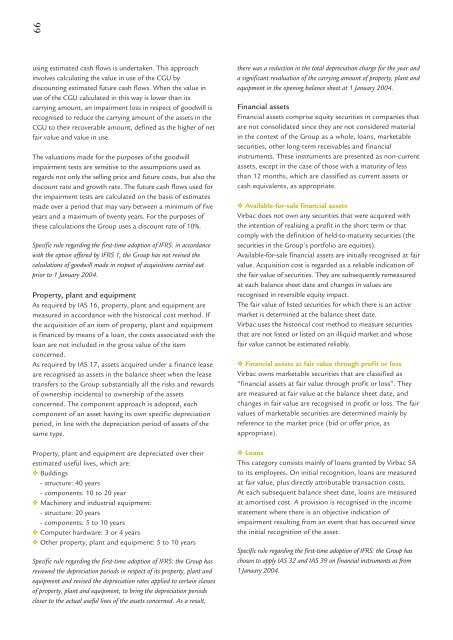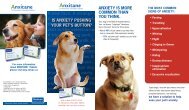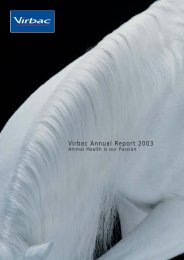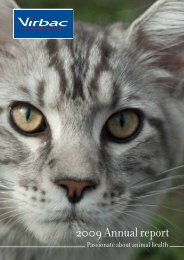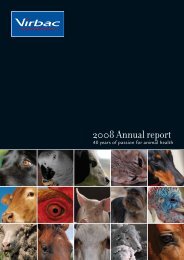2005 Annual report - Virbac
2005 Annual report - Virbac
2005 Annual report - Virbac
Create successful ePaper yourself
Turn your PDF publications into a flip-book with our unique Google optimized e-Paper software.
66<br />
using estimated cash flows is undertaken. This approach<br />
involves calculating the value in use of the CGU by<br />
discounting estimated future cash flows. When the value in<br />
use of the CGU calculated in this way is lower than its<br />
carrying amount, an impairment loss in respect of goodwill is<br />
recognised to reduce the carrying amount of the assets in the<br />
CGU to their recoverable amount, defined as the higher of net<br />
fair value and value in use.<br />
The valuations made for the purposes of the goodwill<br />
impairment tests are sensitive to the assumptions used as<br />
regards not only the selling price and future costs, but also the<br />
discount rate and growth rate. The future cash flows used for<br />
the impairment tests are calculated on the basis of estimates<br />
made over a period that may vary between a minimum of five<br />
years and a maximum of twenty years. For the purposes of<br />
these calculations the Group uses a discount rate of 10%.<br />
Specific rule regarding the first-time adoption of IFRS: in accordance<br />
with the option offered by IFRS 1, the Group has not revised the<br />
calculations of goodwill made in respect of acquisitions carried out<br />
prior to 1 January 2004.<br />
Property, plant and equipment<br />
As required by IAS 16, property, plant and equipment are<br />
measured in accordance with the historical cost method. If<br />
the acquisition of an item of property, plant and equipment<br />
is financed by means of a loan, the costs associated with the<br />
loan are not included in the gross value of the item<br />
concerned.<br />
As required by IAS 17, assets acquired under a finance lease<br />
are recognised as assets in the balance sheet when the lease<br />
transfers to the Group substantially all the risks and rewards<br />
of ownership incidental to ownership of the assets<br />
concerned. The component approach is adopted, each<br />
component of an asset having its own specific depreciation<br />
period, in line with the depreciation period of assets of the<br />
same type.<br />
Property, plant and equipment are depreciated over their<br />
estimated useful lives, which are:<br />
❖ Buildings<br />
- structure: 40 years<br />
- components: 10 to 20 year<br />
❖ Machinery and industrial equipment:<br />
- structure: 20 years<br />
- components: 5 to 10 years<br />
❖ Computer hardware: 3 or 4 years<br />
❖ Other property, plant and equipment: 5 to 10 years<br />
Specific rule regarding the first-time adoption of IFRS: the Group has<br />
reviewed the depreciation periods in respect of its property, plant and<br />
equipment and revised the depreciation rates applied to certain classes<br />
of property, plant and equipment, to bring the depreciation periods<br />
closer to the actual useful lives of the assets concerned. As a result,<br />
there was a reduction in the total depreciation charge for the year and<br />
a significant revaluation of the carrying amount of property, plant and<br />
equipment in the opening balance sheet at 1 January 2004.<br />
Financial assets<br />
Financial assets comprise equity securities in companies that<br />
are not consolidated since they are not considered material<br />
in the context of the Group as a whole, loans, marketable<br />
securities, other long-term receivables and financial<br />
instruments. These instruments are presented as non-current<br />
assets, except in the case of those with a maturity of less<br />
than 12 months, which are classified as current assets or<br />
cash equivalents, as appropriate.<br />
❖ Available-for-sale financial assets<br />
<strong>Virbac</strong> does not own any securities that were acquired with<br />
the intention of realising a profit in the short term or that<br />
comply with the definition of held-to-maturity securities (the<br />
securities in the Group’s portfolio are equities).<br />
Available-for-sale financial assets are initially recognised at fair<br />
value. Acquisition cost is regarded as a reliable indication of<br />
the fair value of securities. They are subsequently remeasured<br />
at each balance sheet date and changes in values are<br />
recognised in reversible equity impact.<br />
The fair value of listed securities for which there is an active<br />
market is determined at the balance sheet date.<br />
<strong>Virbac</strong> uses the historical cost method to measure securities<br />
that are not listed or listed on an illiquid market and whose<br />
fair value cannot be estimated reliably.<br />
❖ Financial assets at fair value through profit or loss<br />
<strong>Virbac</strong> owns marketable securities that are classified as<br />
“financial assets at fair value through profit or loss”. They<br />
are measured at fair value at the balance sheet date, and<br />
changes in fair value are recognised in profit or loss. The fair<br />
values of marketable securities are determined mainly by<br />
reference to the market price (bid or offer price, as<br />
appropriate).<br />
❖ Loans<br />
This category consists mainly of loans granted by <strong>Virbac</strong> SA<br />
to its employees. On initial recognition, loans are measured<br />
at fair value, plus directly attributable transaction costs.<br />
At each subsequent balance sheet date, loans are measured<br />
at amortised cost. A provision is recognised in the income<br />
statement where there is an objective indication of<br />
impairment resulting from an event that has occurred since<br />
the initial recognition of the asset.<br />
Specific rule regarding the first-time adoption of IFRS: the Group has<br />
chosen to apply IAS 32 and IAS 39 on financial instruments as from<br />
1 January 2004.


